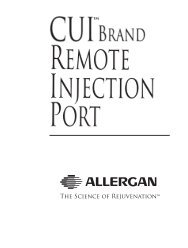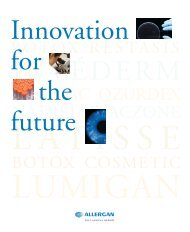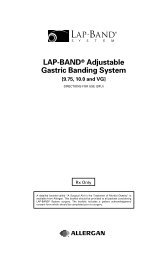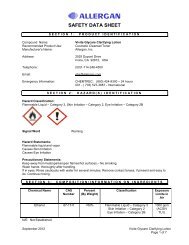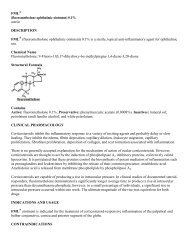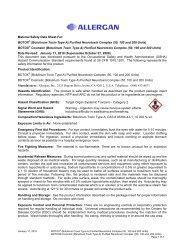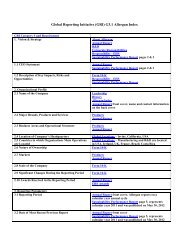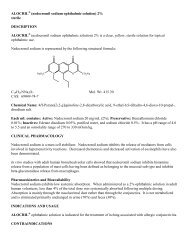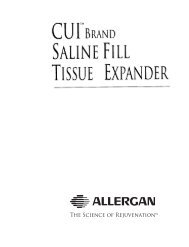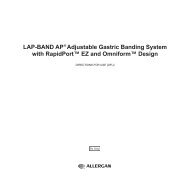NATRELLE™ BIOCELL® Textured and NATRELLE ... - Allergan
NATRELLE™ BIOCELL® Textured and NATRELLE ... - Allergan
NATRELLE™ BIOCELL® Textured and NATRELLE ... - Allergan
- No tags were found...
Create successful ePaper yourself
Turn your PDF publications into a flip-book with our unique Google optimized e-Paper software.
irections for Use<br />
Directions for Use<br />
<strong>NATRELLE</strong> ®<br />
Saline-Filled<br />
Breast Implants<br />
Smooth &<br />
BIOCELL ® Texture<br />
THE SCIENCE OF REJUVENATION
Caution: Federal (USA) law restricts this device to sale by or on the order of a licensed physician.
Table of Contents<br />
Introduction.......................................................................................................................... 1<br />
Directions to the Physician................................................................................................. 1<br />
Device Description............................................................................................................... 1<br />
Indications............................................................................................................................. 3<br />
Contraindications................................................................................................................. 3<br />
Warnings................................................................................................................................ 4<br />
Precautions............................................................................................................................ 5<br />
Important Factors to be Discussed with the Patient........................................................ 7<br />
Adverse Events...................................................................................................................... 8<br />
Other Reported Conditions..............................................................................................10<br />
<strong>Allergan</strong>’s Clinical Studies.................................................................................................11<br />
Instructions for Use............................................................................................................22<br />
Single Use......................................................................................................................22<br />
Product Identification.................................................................................................22<br />
Surgical Planning.........................................................................................................22<br />
Sterile Product..............................................................................................................22<br />
Surgical Procedure.......................................................................................................23<br />
Documentation the Physician Should Provide to the Patient......................................26<br />
Additional Specific Product Information.......................................................................27<br />
<strong>BIOCELL®</strong> Delivery Assistance Sleeve......................................................................27<br />
Returned Goods Policy...............................................................................................27<br />
Reporting <strong>and</strong> Return of Explanted Devices...........................................................27<br />
ConfidencePlus® Limited Warranties........................................................................27<br />
Product Ordering........................................................................................................27<br />
Reporting Problems....................................................................................................27<br />
Page i
Page ii
Introduction<br />
• DIRECTIONS TO THE PHYSICIAN<br />
The information supplied in this Directions for Use document is intended to provide an overview<br />
of essential information about <strong>NATRELLE</strong>® Saline-Filled Breast Implants, including the indications<br />
for use, contraindications, warnings, precautions, important factors for a patient to consider, adverse<br />
events, other reported conditions, <strong>and</strong> a summary of <strong>Allergan</strong>’s clinical results.<br />
Patient Counseling Information<br />
You should review this document prior to counseling the patient about <strong>NATRELLE</strong>® Saline-Filled<br />
Breast Implants <strong>and</strong> breast implant surgery. Please familiarize yourself with the content of this document<br />
<strong>and</strong> resolve any questions or concerns prior to proceeding with use of the device. As with any<br />
surgical procedure, breast implantation is NOT without risks. Breast implantation is an elective procedure,<br />
<strong>and</strong> the patient must be well counseled <strong>and</strong> underst<strong>and</strong> the risk/benefit relationship.<br />
Before making the decision to proceed with surgery, the surgeon or a designated patient counselor<br />
should instruct the patient to read the patient labeling <strong>and</strong> discuss with the patient the warnings,<br />
precautions, important factors to consider, complications, <strong>and</strong> <strong>Allergan</strong>’s clinical results listed in the<br />
patient labeling. The physician should advise the patient of the potential complications <strong>and</strong> that<br />
medical management of serious complications may include additional surgery <strong>and</strong> explantation.<br />
Informed Decision<br />
Before making the decision to proceed with surgery, each patient should receive <strong>Allergan</strong>’s Making an<br />
Informed Decision, Breast Surgery with <strong>NATRELLE</strong>® Saline-Filled Breast Implants patient labeling<br />
to allow her sufficient time prior to surgery to read <strong>and</strong> adequately underst<strong>and</strong> the important information<br />
on the risks, follow-up recommendations, <strong>and</strong> benefits associated with saline-filled breast implant<br />
surgery. Allow the patient at least 1-2 weeks after reviewing <strong>and</strong> considering this information before<br />
deciding whether to have primary breast surgery. In the case of a revision it may be medically necessary<br />
to perform surgery sooner.<br />
Device Description<br />
<strong>NATRELLE</strong>® Saline-Filled Breast Implants are constructed from Room Temperature Vulcanized<br />
(RTV) silicone elastomer, made of polydimethylsiloxane. The device is inflated to the desired size with<br />
sterile isotonic saline before implantation. Each implant is supplied sterile with a disposable fill tube<br />
<strong>and</strong> reflux valve.<br />
Page 1
Round Breast Implants:<br />
Style Number Breast Implant Description Size Range<br />
Style 68LP Smooth shell surface, anterior filling valve, low projection 125cc – 700cc<br />
Style 68MP Smooth shell surface, anterior filling valve, moderate projection 120cc – 850cc<br />
Style 68HP Smooth shell surface, anterior filling valve, high projection 160cc – 850cc<br />
Style 168 <strong>BIOCELL®</strong> <strong>Textured</strong> shell surface, anterior filling valve, moderate projection 120cc – 850cc<br />
Shaped Breast Implants:<br />
Style Number Breast Implant Description Size Range<br />
Style 163 <strong>BIOCELL®</strong> <strong>Textured</strong> shell surface, posterior filling valve, full height, full projection 360cc – 820cc<br />
Style 363LF <strong>BIOCELL®</strong> <strong>Textured</strong> shell surface, anterior filling valve, low height, full projection. 170cc – 720cc<br />
Style 363 has a ptotic shape to match an existing breast in unilateral reconstruction.<br />
Style 468<br />
<strong>BIOCELL®</strong> <strong>Textured</strong> shell surface, anterior filling valve, full height, moderate projection<br />
195cc – 205cc<br />
A = Width; B = Projection<br />
Round Breast Implant<br />
A = Width; B = Height; C= Projection<br />
Shaped Breast Implant<br />
Page 2
Indications<br />
<strong>NATRELLE</strong>® Saline-Filled Breast Implants are indicated for females for the following:<br />
• Breast augmentation for women at least 18 years old. Breast augmentation includes primary<br />
breast augmentation to increase the breast size, as well as revision surgery to correct or improve<br />
the result of a primary breast augmentation surgery.<br />
• Breast reconstruction. Breast reconstruction includes primary reconstruction to replace breast<br />
tissue that has been removed due to cancer or trauma or that has failed to develop properly due<br />
to a severe breast abnormality. Breast reconstruction also includes revision surgery to correct or<br />
improve the result of a primary breast reconstruction surgery.<br />
Contraindications<br />
Breast implant surgery should not be performed in:<br />
• Women with active infection anywhere in their body.<br />
• Women with existing cancer or pre-cancer of their breast who have not received adequate treatment<br />
for those conditions.<br />
• Women who are currently pregnant or nursing.<br />
Surgical Practices in which product use is contraindicated due to compromise of product integrity:<br />
• Adulterated Fill. Do not place drugs or substances inside the implant other than sterile saline for<br />
injection.<br />
• Alteration. Do not alter the implant or valve.<br />
• Do not inject through the implant shell.<br />
• Stacking of implants: Do not place more than one implant per breast pocket<br />
• Do not allow the implant to come into prolonged contact with povidone iodine.<br />
Page 3
Warnings<br />
• Closed Capsulotomy<br />
DO NOT treat capsular contracture by forceful external compression, which will likely result in<br />
implant damage, deflation, folds, <strong>and</strong>/or hematoma. Capsule firmness must not be treated by<br />
overexpansion of the device.<br />
• Reuse<br />
Breast implants are intended for single use only. Do not resterilize.<br />
• Avoiding Damage during Surgery<br />
• Care should be taken not to damage the prosthesis with surgical instruments.<br />
• Do not insert or attempt to repair a damaged prosthesis.<br />
• Use care in subsequent procedures such as open capsulotomy, breast pocket revision, hematoma/seroma<br />
aspiration, <strong>and</strong> biopsy/lumpectomy to avoid damage to the implant shell or valve.<br />
• Do not contact the implant with disposable, capacitor-type cautery devices.<br />
• Proper Filling<br />
Follow the recommended fill volume on the product data sheet; do not overfill or underfill the<br />
implant. Following recommended fill volumes may decrease the possibility of shell wrinkling<br />
<strong>and</strong> crease fold failure.<br />
• Microwave Diathermy<br />
The use of microwave diathermy in patients with breast implants is not recommended, as it has<br />
been reported to cause tissue necrosis, skin erosion, <strong>and</strong> extrusion of the implant.<br />
• Use of endoscopic instruments or the periumbilical approach for placement of the implant has<br />
not been studied in the <strong>Allergan</strong> clinical trial <strong>and</strong> is not recommended as damage to the device<br />
may occur.<br />
Page 4
Precautions<br />
Specific Populations<br />
Safety <strong>and</strong> effectiveness have not been established in patients with the following:<br />
• Autoimmune diseases (e.g., lupus <strong>and</strong> scleroderma).<br />
• A compromised immune system (for example, currently receiving immunosuppressive therapy).<br />
• Conditions or medications which interfere with wound healing <strong>and</strong> blood clotting.<br />
• Reduced blood supply to breast tissue.<br />
• Radiation to the breast following implantation.<br />
• Clinical diagnosis of depression or other mental health disorders, including body dysmorphic<br />
disorder <strong>and</strong> eating disorders. Please discuss any history of mental health disorders prior to surgery.<br />
Patients with a diagnosis of depression, or other mental health disorders, should wait until<br />
resolution or stabilization of these conditions prior to undergoing breast implantation surgery.<br />
Surgical Precautions<br />
• Surgical technique<br />
The implantation of breast implants involves a variety of surgical techniques. Therefore, the surgeon<br />
is advised to use the method which her/his own practice <strong>and</strong> discretion dictate to be best<br />
for the patient, consistent with this Directions for Use document. It is advisable to have more<br />
than one size breast implant in the operating room at the time of surgery to allow for flexibility in<br />
determining the appropriate size implant to be used. A backup implant should also be available.<br />
• Implant Selection<br />
Some of the important surgical <strong>and</strong> implant sizing variables that have been identified include the<br />
following:<br />
• <strong>Textured</strong> implants, larger implants, subgl<strong>and</strong>ular placement, <strong>and</strong> an insufficient amount of<br />
skin/tissue available to cover the implant may cause the implant to be more palpable.<br />
• The implant should be consistent in size with the patient’s chest wall dimensions, including<br />
base width measurements, bearing in mind the laxity of the tissue <strong>and</strong> the projection of the<br />
implant.<br />
Page 5
• A thorough discussion should be conducted with the patient, employing appropriate visual<br />
aids such as imaging, sizing implants, or other options to clarify her objectives <strong>and</strong> reduce the<br />
incidence of reoperation for size change.<br />
• Available tissue must provide adequate coverage of the implant.<br />
• Incision Site Selection<br />
• The periareolar site is typically more concealed, but it is associated with a higher likelihood<br />
of difficulties in successfully breast feeding as compared to other incision sites. A periareolar<br />
incision may result in changes in nipple sensation.<br />
• The inframammary incision is generally less concealed than the periareolar, but it is associated<br />
with less breast feeding difficulty than the periareolar incision site.<br />
• The axillary incision is less concealed than the periareolar site.<br />
• The periumbilical approach has not been studied in the clinical studies <strong>and</strong> should not be<br />
used for a wide variety of reasons, including potential damage to the implant shell.<br />
• Implant Placement Selection<br />
• A well-defined, dry pocket of adequate size <strong>and</strong> symmetry must be created to allow the<br />
implant to be placed flat on a smooth surface.<br />
• Submuscular placement may make surgery last longer, may make recovery longer, may be<br />
more painful, <strong>and</strong> may make it more difficult to perform some reoperation procedures than<br />
subgl<strong>and</strong>ular placement. The possible benefits of this placement are that it may result in less<br />
palpable implants, less likelihood of capsular contracture, <strong>and</strong> easier imaging of the breast<br />
for mammography. Also, submuscular placement may be preferable if the patient has thin or<br />
weakened breast tissue.<br />
• Subgl<strong>and</strong>ular placement may make surgery <strong>and</strong> recovery shorter, may be less painful, <strong>and</strong><br />
may be easier to access for reoperation than the submuscular placement. However, this<br />
placement may result in more palpable implants, greater likelihood of capsular contracture,<br />
<strong>and</strong> increased difficulty in imaging the breast with mammography.<br />
• Explantation<br />
If it is necessary to perform explantation of the implant, care must be taken to minimize manipulation<br />
of the product (particularly in regards to sharp-edged openings). Evaluation of the condition<br />
of the device following explantation will be performed by <strong>Allergan</strong>.<br />
Page 6
Important Factors to be Discussed with the Patient<br />
Breast implantation is an elective procedure <strong>and</strong> the patient must be thoroughly counseled on the<br />
risks, as well as the benefits, of these products <strong>and</strong> procedures. You should advise your patient that<br />
she must read the patient labeling for either augmentation or reconstruction, as applicable. The<br />
patient labeling is intended as the primary means to relate uniform risk <strong>and</strong> benefit information to<br />
assist your patient in making an informed decision about primary breast augmentation <strong>and</strong> revisionaugmentation,<br />
or primary reconstruction <strong>and</strong> revision-reconstruction surgery (as applicable), but is<br />
not intended to replace consultation with you. The patient should review <strong>and</strong> consider this information<br />
before deciding whether to have this surgery.<br />
Below are some of the important factors your patients need to be aware of when using saline-filled<br />
breast implants.<br />
• Reoperation – Patients should be advised that additional surgery to their breast <strong>and</strong>/or implant<br />
will be likely over the course of their life.<br />
• Explantation – Patients should be advised that implants are not considered lifetime devices <strong>and</strong><br />
they will likely undergo implant removal, with or without replacement, over the course of their<br />
life. Patients should also be advised that the changes to their breast following explantation are<br />
irreversible.<br />
• Mammography – Breast implants may complicate the interpretation of mammographic images by<br />
obscuring underlying breast tissue <strong>and</strong>/or by compressing overlying tissue. Accredited mammography<br />
centers <strong>and</strong> use of displacement techniques are needed to adequately visualize breast tissue<br />
in the implanted breast. Presurgical mammography with a follow-up mammogram 6 months to<br />
1 year following surgery may be performed to establish a baseline for future routine mammography.<br />
Patients should be instructed to inform their mammographers about the presence of their<br />
implants.<br />
• Lactation – Patients should be advised that breast implants may interfere with the ability to successfully<br />
breastfeed, either by reducing or eliminating milk production.<br />
• Breast Examination Techniques – Patients should be instructed to perform breast self-examinations<br />
monthly <strong>and</strong> be shown how to distinguish the implant from their breast tissue. The patient<br />
should be instructed not to manipulate (i.e., squeeze) the valve excessively, which may cause valve<br />
leakage.<br />
• Avoiding Damage During Treatment – Patients should inform other treating physicians of the<br />
presence of implants to minimize the risk of damage to the implants.<br />
Page 7
• Smoking – Smoking may interfere with the healing process.<br />
• Radiation to the Breast – <strong>Allergan</strong> has not tested the in vivo effects of radiation therapy in<br />
patients who have breast implants. The literature suggests that radiation therapy may increase the<br />
likelihood of capsular contracture, necrosis, <strong>and</strong> implant extrusion.<br />
• Insurance Coverage – Patients should be advised that health insurance premiums may increase,<br />
insurance coverage may be dropped, <strong>and</strong>/or future coverage may be denied based on the presence<br />
of breast implants. Treatment of complications may not be covered as well. Patients should check<br />
with their insurance company regarding coverage issues before undergoing surgery.<br />
• Mental Health <strong>and</strong> Elective Surgery – It is important that all patients seeking to undergo elective<br />
surgery have realistic expectations that focus on improvement rather than perfection. Request<br />
that your patient openly discuss with you, prior to surgery, any history that she may have of<br />
depression or other mental health disorders.<br />
• Long Term Effects<br />
Safety <strong>and</strong> effectiveness beyond 10 years has not been clinically evaluated.<br />
Adverse Events<br />
Potential adverse events that may occur with saline-filled breast implant surgery include: reoperation,<br />
pain, wrinkling, asymmetry, implant palpability/visibility, implant removal, capsular contracture,<br />
changes in nipple <strong>and</strong> breast sensation, implant displacement/migration, implant deflation, scarring,<br />
infection, hematoma/seroma, breastfeeding complications, implant extrusion, necrosis, delayed<br />
wound healing, breast tissue atrophy/chest wall deformity, calcium deposits, <strong>and</strong> lymphadenopathy.<br />
Below is a description of these adverse events. For specific adverse event rates/outcomes for<br />
<strong>NATRELLE</strong>® Saline-filled Breast Implants, refer to <strong>Allergan</strong>’s Clinical Study section below.<br />
• Deflation – Breast implants are not lifetime devices. Saline breast implants deflate when the shell<br />
develops a tear or hole. Deflation can occur at any time after implantation, but they are more<br />
likely to occur the longer the implant is implanted. The following things may cause implants<br />
to deflate: damage by surgical instruments; folding or wrinkling of the implant shell; excessive<br />
force to the chest (e.g., during closed capsulotomy, which is contraindicated); trauma; compression<br />
during mammographic imaging; <strong>and</strong> severe capsular contracture. Breast implants may also<br />
simply wear out over time. Laboratory studies have identified some of the causes of deflation for<br />
<strong>Allergan</strong>’s product; however, it is not conclusively known whether these tests have identified all<br />
causes of deflation.<br />
Page 8
• Capsular Contracture – Patients should be advised that capsular contracture may be more common<br />
following infection, hematoma, <strong>and</strong> seroma, <strong>and</strong> the chance of it happening may increase<br />
over time. Capsular contracture occurs more commonly in revision patients than in primary augmentation<br />
or reconstruction patients. Capsular contracture is also a risk factor for implant deflation,<br />
<strong>and</strong> it is one of the most common reasons for reoperation.<br />
Patients should also be advised that additional surgery may be needed in cases where pain <strong>and</strong>/<br />
or firmness are severe. This surgery ranges from removal of the implant capsule tissue to removal<br />
<strong>and</strong> possible replacement of the implant itself. This surgery may result in loss of breast tissue.<br />
Capsular contracture may happen again after these additional surgeries. Capsular contracture<br />
may increase the risk of deflation.<br />
• Reoperation – Patients should be advised that additional surgery to their breast <strong>and</strong>/or implant<br />
will likely be necessary over the course of their life. Patients may decide to change the size or type<br />
of their implants, requiring a reoperation, or they may have a reoperation to improve or correct<br />
their outcome.<br />
• Implant Removal – Patients should be advised that implants are not considered lifetime devices,<br />
<strong>and</strong> they will potentially undergo implant removal, with or without replacement, over the course<br />
of their life. Patients should also be advised that the changes to their breast following explantation<br />
are irreversible.<br />
• Pain – Pain of varying intensity <strong>and</strong> length of time may occur <strong>and</strong> persist following breast implant<br />
surgery. In addition, improper size, placement, surgical technique, or capsular contracture may<br />
result in pain. Patients should be advised to contact their surgeon if there is significant pain or if<br />
pain persists.<br />
• Changes in Nipple <strong>and</strong> Breast Sensation – Feeling in the nipple <strong>and</strong> breast can increase or<br />
decrease after implant surgery, is typically lost after complete mastectomy where the nipple itself<br />
is removed, <strong>and</strong> can be severely lessened by partial mastectomy. Radiation therapy also can significantly<br />
reduce sensation in the remaining portions of the breast or chest wall. The placement<br />
of breast implants for reconstruction may further lessen the sensation in the remaining skin or<br />
breast tissue. The range of changes varies from intense sensitivity to no feeling in the nipple or<br />
breast following surgery. While some of these changes can be temporary, they can also be permanent,<br />
<strong>and</strong> may affect the patient’s sexual response or ability to nurse.<br />
• Infection – In rare instances, acute infection may occur in a breast with implants. The signs of<br />
acute infection include erythema, tenderness, fluid accumulation, pain, <strong>and</strong> fever. Very rarely,<br />
Toxic Shock Syndrome, a potentially life-threatening condition, has been reported in women<br />
after breast implant surgery. It is characterized by symptoms that occur suddenly <strong>and</strong> include<br />
Page 9
high fever (102°F, 38.8°C or higher), vomiting, diarrhea, a sunburn-like rash, red eyes, dizziness,<br />
lightheadedness, muscle aches, <strong>and</strong> drops in blood pressure, which may cause fainting. Patients<br />
should be advised to contact a physician immediately for diagnosis <strong>and</strong> treatment for any of these<br />
symptoms.<br />
• Unsatisfactory Results – Patients should be informed that dissatisfaction with cosmetic results<br />
related to such things as scar deformity, hypertrophic scarring, capsular contracture, asymmetry,<br />
wrinkling, implant displacement/migration, incorrect size, <strong>and</strong> implant palpability/visibility may<br />
occur. Careful surgical planning <strong>and</strong> technique can minimize, but not preclude, the risk of such<br />
results. Pre-existing asymmetry may not be entirely correctable. Revision surgery may be indicated<br />
to maintain patient satisfaction but carries additional considerations <strong>and</strong> risks.<br />
• Breastfeeding Complications – Breastfeeding difficulties have been reported following breast<br />
surgery, including breast reduction <strong>and</strong> breast augmentation surgery. A periareolar surgical<br />
approach may further increase the chance of breastfeeding difficulties.<br />
• Additional Complications – After breast implant surgery the following may occur <strong>and</strong>/or persist,<br />
with varying intensity <strong>and</strong>/or for a varying length of time: hematoma/seroma, implant extrusion,<br />
necrosis, delayed wound healing, <strong>and</strong> breast tissue atrophy/chest wall deformity. Calcium deposits<br />
can form in the tissue capsule surrounding the implant with symptoms that may include pain<br />
<strong>and</strong> firmness. Lymphadenopathy has also been reported in some women with implants.<br />
Other Reported Conditions<br />
There have been reports in the literature of other conditions in women with breast implants. Many<br />
of these conditions have been studied to evaluate their potential association with breast implants. No<br />
cause-<strong>and</strong>-effect relationship has been established between breast implants <strong>and</strong> the conditions listed<br />
below. Furthermore, there is the possibility of risks, yet unknown, which in the future could be determined<br />
to be associated with breast implants. It should also be noted that the cited references include<br />
data from augmentation <strong>and</strong>/or reconstruction patients, as well as from a variety of manufacturers <strong>and</strong><br />
implant models.<br />
• Connective Tissue Disease (CTD)<br />
Concern over the association of breast implants to the development of autoimmune or connective<br />
tissue diseases, such as lupus, scleroderma, or rheumatoid arthritis, was raised because of cases<br />
reported in the literature with small numbers of women with implants. A review of several large<br />
epidemiological studies of women with <strong>and</strong> without implants indicates that these diseases are no<br />
more common in women with implants than those in women without implants.<br />
Page 10
• Cancer<br />
Published studies indicate that breast cancer is no more common in women with implants than<br />
those without implants. A large, long-term follow-up found no significant increases in the risk<br />
rates for a wide variety of cancers, including stomach cancer, leukemia, <strong>and</strong> lymphoma.<br />
Based on information reported to FDA <strong>and</strong> found in medical literature, a possible association has<br />
been identified between breast implants <strong>and</strong> the rare development of anaplastic large cell lymphoma<br />
(ALCL), a type of non-Hodgkin’s lymphoma. Women with breast implants may have a very<br />
small but increased risk of developing ALCL in the fluid or scar capsule adjacent to the implant.<br />
ALCL has been reported globally in patients with an implant history that includes <strong>Allergan</strong>’s <strong>and</strong><br />
other manufacturers’ breast implants.<br />
You should consider the possibility of ALCL when you have a patient with late onset, persistent<br />
peri-implant seroma. In some cases, patients presented with capsular contracture or masses<br />
adjacent to the breast implant. When testing for ALCL, collect fresh seroma fluid <strong>and</strong> representative<br />
portions of the capsule, <strong>and</strong> send for pathology tests to rule out ALCL. If your patient is<br />
diagnosed with peri-implant ALCL, develop an individualized treatment plan in coordination<br />
with a multi-disciplinary care team. Because of the small number of cases worldwide, there is no<br />
defined consensus treatment regimen for peri-implant ALCL.<br />
For more complete <strong>and</strong> up-to-date information on FDA’s analysis <strong>and</strong> review of the<br />
ALCL in patients with breast implants please visit: http://www.fda.gov/MedicalDevices/<br />
Products<strong>and</strong>MedicalProcedures/Implants<strong>and</strong>Prosthetics/BreastImplants/ucm239995.htm<br />
• Effects on Children<br />
There have been concerns raised regarding potential damaging effects on children born of mothers<br />
with implants. A review of the published literature on this issue suggests that the information<br />
is insufficient to draw definitive conclusions.<br />
<strong>Allergan</strong>’s Clinical Studies<br />
Clinical Studies Overview<br />
<strong>Allergan</strong>’s Saline-Filled Breast Implants were evaluated in four major open label, multicenter clinical<br />
studies: the Large Simple Trial (LST, which involved 2,875 patients), the 1995 Augmentation<br />
Study (A95, which involved 901 patients), the 1995 Reconstruction Study (R95, which involved 237<br />
patients), <strong>and</strong> the Post Approval Survey Study (PASS, which was a continuation of the A95/R95 studies).<br />
Page 11
Study Design<br />
Patients studied were those seeking implant surgery for augmentation or reconstruction of the breast.<br />
The LST Study was designed as a 1 year study to assess the 4 safety outcomes of capsular contracture,<br />
infection, implant leakage/deflation, <strong>and</strong> implant removal for a large number of patients. As the results<br />
from that study were similar to those found in the larger studies, the data are not reported here.<br />
The A95/R95 Studies were designed as 5 year studies to assess safety <strong>and</strong> effectiveness. Patient followup<br />
was yearly for 5 years. Safety assessments in the A95/R95 Studies consisted of adverse event rates<br />
<strong>and</strong> rates of secondary surgical treatment. Effectiveness assessments in the A95/R95 Studies consisted<br />
of patient satisfaction, breast size change, <strong>and</strong> measures of body esteem/self esteem/body image. The<br />
PASS study utilized patient surveys for collection of specific risk/benefit information 6 through10<br />
years post implant.<br />
Five-year data from the A95/R95 study <strong>and</strong> 10-year data from the PASS study are presented in this<br />
brochure.<br />
Patient Accounting <strong>and</strong> Baseline Demographic Profile<br />
The A95 Study enrolled 901 augmentation patients. Of those A95 patients available to be seen for<br />
their 5-year follow-up visit, 81% returned <strong>and</strong> were seen at 5 years after implant surgery. The R95<br />
Study enrolled 237 reconstruction patients. Of those R95 patients available to be seen for their 5-year<br />
follow-up visit, 80% returned <strong>and</strong> were seen at 5 years after implant surgery. Demographic information<br />
obtained from the 1995 Studies revealed that nearly 90% of both augmentation <strong>and</strong> reconstruction<br />
patients were Caucasian <strong>and</strong> more than half of study participants were married. The median age of<br />
the augmentation patients was 32 years (range 19-66); for reconstruction patients the median age was<br />
47 years (range 25-77). With respect to surgical baseline factors in the 1995 Studies, for augmentation<br />
patients, the most frequently used devices were textured round, the most common incision sites were<br />
periareolar <strong>and</strong> inframammary, <strong>and</strong> the most frequent placement of the implant was submuscular. For<br />
reconstruction patients, the most frequently used devices were textured shaped, the most common<br />
incision site was the mastectomy scar, <strong>and</strong> the most frequent placement of the implant was submuscular.<br />
The post-approval study transitioned patients from data collection via physicians (0-5 years postimplantation)<br />
to data collection via mailed patient-completed surveys (6-10 years post-implantation).<br />
85% of the augmentation patients <strong>and</strong> 86% of the reconstruction patients expected for follow-up at 10<br />
years returned surveys to <strong>Allergan</strong> according to study protocol.<br />
Effectiveness Outcomes<br />
The benefits of saline-filled breast implants were assessed by a variety of outcomes, including bra cup<br />
size change (augmentation patients only), body image, body esteem, self concept, <strong>and</strong> patient satisfac-<br />
Page 12
tion. Bra cup size was measured within the first year <strong>and</strong> a half after surgery. Body image, esteem,<br />
<strong>and</strong> self concept were assessed for patients with both original <strong>and</strong> replacement saline devices before<br />
implantation <strong>and</strong> at 3 years after surgery. Satisfaction was measured at every follow-up visit through 5<br />
years.<br />
Augmentation<br />
859 (95%) of the original 901 augmentation patients had a breast measurement within 18 months<br />
of surgery. Of these 859 patients, 38% increased by 1 cup size; 49% increased by 2 cup sizes; 9%<br />
increased by 3 cup sizes, <strong>and</strong> 4% had no increase.<br />
Of the original 901 augmentation patients, 683 (76%) provided a satisfaction rating at 5 years, with<br />
95% indicating they were satisfied with their breast implants. The patient surveys showed 88% of the<br />
augmentation patients who provided satisfaction scores were satisfied with their breast implants at 10<br />
years post-implant.<br />
Quality of life assessments were obtained prior to implantation <strong>and</strong> at 6 months, 1 year, <strong>and</strong> 3 years<br />
after surgery. Before implantation, augmentation patients scored higher (better) than the general U.S.<br />
female population on the SF-36 scales, which measure general health-related quality of life. After<br />
3 years, augmentation patients showed a slight worsening in their SF-36 scores, although all scales<br />
remained higher than the general U.S. female population. The Rosenberg Self Esteem Scale (which<br />
measures overall self esteem) <strong>and</strong> the Tennessee Self Concept Scale (which measures overall self concept)<br />
showed slight improvements over the 3 years. The Body Esteem Scale (which measures overall<br />
body image) showed a slight worsening overall but a large improvement in body esteem related to<br />
sexual attractiveness at 3 years.<br />
Breast satisfaction was significantly increased after 3 years, including satisfaction with breast shape,<br />
size, feel or touch, <strong>and</strong> how well they matched (Table 1).<br />
Table 1. Change from Pre-Surgery in Breast Satisfaction Scale<br />
Primary Augmentation<br />
Quality of Life Scale<br />
Year 1 Year 3<br />
Satisfaction with Breasts Improved Improved<br />
How Well Breasts Matched Improved Improved<br />
Satisfaction with Breast Shape Improved Improved<br />
Satisfaction with Breast Size Improved Improved<br />
Satisfaction with Breast Feel/Touch Improved Improved<br />
Page 13
Reconstruction<br />
Of the original 237 reconstruction patients, 137 (58%) provided a satisfaction rating at 5 years, with<br />
89% indicating they were satisfied with their breast implants. The patient surveys showed 86% of the<br />
reconstruction patients who provided satisfaction scores were satisfied with their breast implants at 10<br />
years post-implant.<br />
Before implantation, reconstruction patients scored higher (better) than the general U.S. female<br />
population on all but one of the SF-36 scales, which measure general health-related quality of life.<br />
After 3 years, reconstruction patients showed an improvement in that SF-36 score to above the rate<br />
for the general U.S. female population. The following 3 overall scales showed no change over the 3<br />
years: Tennessee Self Concept Scale (which measures overall self concept), Rosenberg Self Esteem<br />
Scale (which measures overall self-esteem), <strong>and</strong> the Body Esteem Scale (which measures overall body<br />
image).<br />
Breast satisfaction was significantly increased after 3 years, including overall satisfaction <strong>and</strong> how well<br />
they matched.<br />
Safety Outcomes<br />
The A95 Study <strong>and</strong> R95 Study safety outcomes for primary implantation are presented in Tables 2<br />
through 7.<br />
The cumulative Kaplan-Meier risk of first occurrence of adverse events (<strong>and</strong> 95% confidence interval)<br />
is shown in Table 1 for the A95/R95 Study <strong>and</strong> Table 2 for the PASS Study. The rates reflect the number<br />
of patients out of 100 who experienced the listed complication at least once within the first 5 or 10<br />
years after their implantation. Some complications occurred more than once for some patients.<br />
Page 14
Complication*<br />
Table 2<br />
Complications<br />
A95/R95: 5-Year Cumulative First Occurrence Kaplan-Meier Risk Rates, By Patient<br />
Augmentation<br />
(N=901)<br />
5-Year<br />
Reconstruction<br />
(N=237)<br />
5-Year<br />
Rate (%) (95% CI) Rate (%) (95% CI)<br />
Reoperation 25.9 (23.0, 28.9) 44.5 (37.9, 51.0)<br />
Breast Pain 17.0 (14.5, 19.5) 17.7 (12.4, 23.0)<br />
Wrinkling 13.7 (11.3, 16.1) 24.6 (18.6, 30.6)<br />
Asymmetry 12.2 (10.0, 14.4) 39.0 (32.1, 45.8)<br />
Implant Palpability/Visibility 12.1 (9.8, 14.3) 27.1 (20.6, 33.5)<br />
Implant Removal for Any Reason 11.8 (9.6, 14.0) 28.0 (22.1, 34.0)<br />
Capsular Contracture Baker Grade III/IV 11.4 (9.2, 13.5) 35.7 (29.0, 42.4)<br />
Loss of Nipple Sensation 9.9 (7.8, 11.9) 18.1 (12.5, 23.8)<br />
Nipple Paresthesia 9.8 (7.8, 11.8)
Complication<br />
Table 3<br />
Complications<br />
Post Approval: 10 Year First Occurrence Kaplan-Meier Risk Rates, By Patient<br />
Augmentation<br />
(N = 901 )<br />
10-Year Risk<br />
Reconstruction<br />
(N = 237 )<br />
Rate (%) (95% CI) Rate (%) (95% CI)<br />
Reoperation 36.5 (33.4, 39.9) 54.6 (48.1, 61.5)<br />
Breast Pain 29.7 (26.6, 33.0) 33.0 (26.4, 40.7)<br />
Capsular Contracture Baker Grade III/IV 20.8 (18.1, 23.8) 51.7 (44.6, 59.2)<br />
Implant Replacement/Removal 20.2 (17.7, 23.1) 39.5 (33.3, 46.5)<br />
Implant Deflation 13.8 (11.5, 16.4) 22.5 (16.8, 29.7)<br />
Reasons for Reoperations<br />
Table 4 shows the reasons for augmentation reoperation 5 years post-implantation from the A95 Study<br />
<strong>and</strong> 10 years post-implantation from the PASS Study based on the total number of reoperations.<br />
Of the 901 augmentation patients in the A95 Study, at least one reoperation was performed on 225<br />
patients (25%) through 5 years. A total of 293 reoperations were performed. The primary reason for<br />
reoperation through 5 years was implant deflation at 18.1%.<br />
In the PASS Study, at least 1 reoperation was performed on 315 patients (36.5%) through 10 years. A<br />
total of 424 reoperations were performed. The primary reason for reoperation through 10 years on<br />
augmentation patients was implant deflation at 21.7%. The percentage of reoperations due to lump/<br />
mass/cyst increased from 8.5% of 293 reoperations through 5 years to 13.9% of 424 reoperations<br />
through 10 years. The occurrence of lumps, masses, <strong>and</strong> cysts can be expected to naturally increase as<br />
patients age <strong>and</strong> could be an explanation for the increase.<br />
Page 16
Reasons for Reoperation*<br />
Table 4<br />
Augmentation: Main Reasons for Reoperation Through 5 <strong>and</strong> 10 Years<br />
5 Years 10 Years<br />
N = 293 N= 424<br />
n % n %<br />
Implant Deflation 53 18.1 92 21.7<br />
Capsular Contracture 52 17.7 56 13.2<br />
Implant Malposition 27 9.2 31 7.3<br />
Lump/Mass/Cyst 25 8.5 59 13.9<br />
Patient Request for Style/Size Change 25 8.5 48 11.3<br />
Hematoma/Seroma 25 8.5 29 6.8<br />
Scarring 20 6.8 20 4.7<br />
Ptosis 14 4.8 26 6.1<br />
Asymmetry 12 4.1 13 3.1<br />
Add/Remove Saline 9 3.1 13 3.1<br />
Wrinkling 7 2.4 8 1.9<br />
Implant Palpability 4 1.4 5 1.2<br />
Delayed Wound Healing 4 1.4 4 0.9<br />
Infection 4 1.4 4 0.9<br />
Nipple Complications 4 1.4 4 0.9<br />
Skin Lesion/Cyst 3 1.0 3 0.7<br />
Breast Pain 2 0.7 2 0.5<br />
Capsule Calcification 1 0.3 1 0.2<br />
Implant Extrusion 1 0.3 1 0.2<br />
Irritation 1 0.3 1 0.2<br />
Cancer 0 0.0 4 0.9<br />
Total 293 100.0 424 100.0<br />
*The reoperation rate excludes planned secondary surgeries. If more than one reason for a given reoperation was reported, the following hierarchy<br />
was used to determine a primary reason for that reoperation: implant deflation; infection; capsular contracture; extrusion; necrosis; hematoma/<br />
seroma; delayed wound healing; skin lesion/cyst; breast pain; irritation; capsule calcification; implant malposition; wrinkling; implant palpability;<br />
asymmetry; ptosis; scarring; nipple complications; cancer; lump/mass/cyst; patient request for style/size change; <strong>and</strong> add/remove saline.<br />
Page 17
Table 5 shows the reasons for reconstruction reoperation through 5 years in the R95 Study <strong>and</strong> 10<br />
years in the PASS Study based on the total number of reoperations.<br />
Of the 237 patients in the R95 Study, at least 1 reoperation was performed on 99 patients (42%) for a<br />
total of 125 reoperations through 5 years. The primary reason for reoperation through 5 years was<br />
capsular contracture at 25.6%.<br />
In the PASS Study, at least one unplanned reoperation was performed on 120 patients (50.6%) through<br />
10 years. A total of 159 reoperations were performed. The primary reason for reoperation through 10<br />
years on reconstruction patients was also capsular contracture at 21.4%.<br />
Table 5<br />
Reconstruction: Main Reasons for Reoperation Through 5 <strong>and</strong> 10 Years<br />
5 Years 10 Years<br />
Reasons for Reoperation*<br />
N = 125 N= 159<br />
n % n %<br />
Capsular Contracture 32 25.6 34 21.4<br />
Asymmetry 17 13.6 17 10.7<br />
Implant Deflation 11 8.8 29 18.2<br />
Patient Request for Style/Size Change 10 8.0 14 8.8<br />
Scarring 10 8.0 10 6.3<br />
Lump/Mass/Cyst 9 7.2 15 9.4<br />
Infection 9 7.2 9 5.7<br />
Hematoma/Seroma 5 4.0 5 3.1<br />
Implant Extrusion 5 4.0 5 3.1<br />
Implant Malposition 4 3.2 6 3.8<br />
Tissue/Skin Necrosis 4 3.2 4 2.5<br />
Wrinkling 3 2.4 3 1.9<br />
Delayed Wound Healing 2 1.6 2 1.3<br />
Skin Lesion/Cyst 2 1.6 2 1.3<br />
Nipple Complications 1 0.8 2 1.3<br />
Implant Palpability 1 0.8 1 0.6<br />
Cancer 0 0.0 1 0.6<br />
Total 125 100.0 159 100.0<br />
*The reoperation rate excludes planned secondary surgeries. If more than one reason for a given reoperation was reported, the following hierarchy<br />
was used to determine a primary reason for that reoperation: implant deflation; infection; capsular contracture; extrusion; necrosis; hematoma/<br />
seroma; delayed wound healing; skin lesion/cyst; breast pain; irritation; capsule calcification; implant malposition; wrinkling; implant palpability;<br />
asymmetry; ptosis; scarring; nipple complications; cancer; lump/mass/cyst; patient request for style/size change; <strong>and</strong> add/remove saline.<br />
Page 18
Reasons for Implant Removal<br />
Of the 901 augmentation patients in A95, there were a total of 98 patients (10.9%) who had 166<br />
implants removed through 5 years. Of the 166 augmentation implants removed through 5 years, 94%<br />
were replaced. The most common reason for implant removal was patient choice for style/size change<br />
(43.4%). Through 10 years, 300 implants were removed from 170 patients. The most common reason<br />
was also patient choice for style/size change (41.3%).<br />
The primary reason for implant removal in augmentation patients based on the number of implants<br />
removed is shown in Table 6 below.<br />
Table 6<br />
Augmentation: Reasons for Implant Removal Through 5 <strong>and</strong> 10 Years<br />
5 Years 10 Years<br />
Primary Reason for Implant Removal<br />
N = 166 N = 300<br />
n % n %<br />
Patient Choice for Size/Style Change 72 43.4 124 41.3<br />
Implant Deflation* 54 32.5 100 33.3<br />
Capsular Contracture 17 10.2 27 9.0<br />
Wrinkling 6 3.6 8 2.7<br />
Implant Palpability/Visibility 6 3.6 6 2.0<br />
Asymmetry 3 1.8 8 2.7<br />
Breast Pain 3 1.8 3 1.0<br />
Malposition 2 1.2 16 5.3<br />
Iatrogenic Injury 1 0.6 1 0.3<br />
Infection 1 0.6 2 0.7<br />
Implant Extrusion 1 0.6 1 0.3<br />
Breast Mass/Lump/Cyst 0 0 4 1.3<br />
Total 166 100 300 99.9<br />
*Includes unreported/unknown (n=1 augmentation)<br />
Of the 237 reconstruction patients in R95, there were 62 patients (26.2%) who had 70 implants<br />
removed through 5 years. Of the 70 reconstruction implants removed through 5 years, 70% were<br />
replaced. The most common reason for implant removal was capsular contracture (31.4%). Through<br />
10 years, there were 104 implants removed from 85 patients. The most common reason for implant<br />
removal was implant leakage/deflation (32.7%).<br />
Page 19
The main reasons for implant removal in reconstruction patients are shown in Table 7 below.<br />
Table 7<br />
Reconstruction: Reasons for Implant Removal Through 5 <strong>and</strong> 10 Years<br />
Primary Reason for Implant Removal<br />
5 Years 10 Years<br />
N = 70 N = 104<br />
n percent n percent<br />
Capsular Contracture 22 31.4 22 21.2<br />
Patient Choice for Style/Size Change 15 21.4 26 25.0<br />
Implant Deflation* 12 17.1 34 32.7<br />
Infection 7 10.0 7 6.7<br />
Implant Extrusion 4 5.7 4 3.8<br />
Implant Malposition 3 4.3 3 2.9<br />
Other** 3 4.3 3 2.9<br />
Wrinkling 2 2.9 2 1.9<br />
Asymmetry 1 1.4 2 1.9<br />
Recurrent Breast Cancer 1 1.4 1 1.0<br />
Total 70 100 104 100.0<br />
*Includes unreported/unknown (n=2 reconstruction)<br />
**Other reasons as reported by the physician were Abnormality on CT Scan at Mastectomy Site (n=1), Tissue Expansion Went Poorly Due to<br />
Radiation (n=1), Second Stage Breast Recon (n=1)<br />
As additional safety information, Table 8 shows the 5-year cumulative Kaplan-Meier adverse event<br />
risk rates of first occurrence following implant replacement (i.e., revision) on a by implant basis for the<br />
A95 <strong>and</strong> R95 Studies. There were 126 augmentation implants <strong>and</strong> 40 reconstruction implants in the<br />
A95/R95 Studies that were removed <strong>and</strong> replaced with <strong>Allergan</strong> study devices.<br />
Table 8<br />
A95/R95: 5 Year Cumulative First Occurrence Kaplan Meier Risk Rates<br />
Following Implant Replacement, by Implant<br />
Augmentation<br />
N = 126 Implants<br />
Reconstruction<br />
N = 40 Implants<br />
Complication Following Replacement of Implants<br />
% 95% CI % 95% CI<br />
Removal/Replacement 18.3 (12.7, 25.9) 28.2 (17.2, 44.0)<br />
Capsular Contracture Baker Grade III/IV 13.2 (8.3, 20.6) 42.4 (27.8, 60.6)<br />
Leakage/Deflation 9.0 (5.4, 14.6) 15.4 (6.9, 32.3)<br />
Page 20
Other Clinical Data Findings<br />
This section summarizes post-implant observations from the A95 <strong>and</strong> R95 Studies pertaining to<br />
connective tissue/autoimmune (CTD) disease <strong>and</strong> breast disease (including breast carcinoma). These<br />
data should be interpreted with caution in that there was no comparison group of similar women<br />
without implants. Confirmed reports were based on a diagnosis by a physician. Data pertaining<br />
to effects on offspring <strong>and</strong> mammographic detection of tumors/lesions were not collected in these<br />
studies.<br />
Breast Disease<br />
Through 5 years, there were 81 reports of breast disease for augmentation patients; eighty (80) were<br />
benign <strong>and</strong> one incident was malignant.<br />
For the reconstruction patients, there were 99 reports of breast disease; 75 were benign <strong>and</strong> 24 were<br />
malignant.<br />
CTD<br />
For augmentation patients through 5 years, there were 7 confirmed reports of CTD disease (3<br />
instances of Graves’ Disease, <strong>and</strong> 2 instances each of hyperthyroiditis <strong>and</strong> chronic fatigue syndrome/<br />
fibromyaglia).<br />
For reconstruction patients through 5 years, there was one confirmed report of Graves’ disease.<br />
CTD Signs <strong>and</strong> Symptoms<br />
In the pivotal study, self-reported signs <strong>and</strong> symptoms were collected in the categories of General,<br />
Gastrointestinal, Neurological, Urinary, Global, Pain, Fatigue, Fibromyalgia, Joint, Muscular, Skin,<br />
<strong>and</strong> Other. For Primary Augmentation patients, no significant increases were found. Statistically<br />
significant increases were found for Primary Reconstruction patients in the symptom categories of<br />
Joint <strong>and</strong> Pain at 4 years.<br />
The pivotal study was not designed to evaluate the cause <strong>and</strong> effect associations because there is<br />
no comparison group of women without implants, <strong>and</strong> because other contributing factors, such as<br />
medications <strong>and</strong> lifestyle/exercise, were not studied. Therefore, it cannot be determined whether this<br />
increase was due to the implants or not, based on the pivotal study. However, a patient should be<br />
aware that she may experience an increase in these symptoms after receiving breast implants.<br />
Page 21
Instructions for Use<br />
NOTE: Back-up breast implants should be available during the procedure.<br />
DO NOT use more than one implant per breast.<br />
Single Use<br />
This product is intended for single use only. Do not reuse explanted implants.<br />
Product Identification<br />
Product identification stickers accompanying each device are provided within the internal product<br />
packaging. The stickers provide product-specific information <strong>and</strong> are designed to be attached to the<br />
patient’s chart for identification purposes. The Device Identification Card should be provided to the<br />
patient for personal reference.<br />
Surgical Planning<br />
<strong>Allergan</strong> relies on the surgeon to know <strong>and</strong> follow the proper surgical procedures with <strong>NATRELLE</strong>®<br />
Saline-Filled breast implants. Proper surgical planning such as allowance for adequate tissue coverage,<br />
implant placement (i.e., submuscular vs. subgl<strong>and</strong>ular), incision site, implant type etc., should<br />
be made preoperatively. The surgeon must carefully evaluate implant size <strong>and</strong> contour, incision<br />
placement, pocket dissection, <strong>and</strong> implant placement criteria with respect to the patient’s anatomy<br />
<strong>and</strong> desired physical outcome. Planning should include clear delineation of aesthetic goals to ensure<br />
mutual underst<strong>and</strong>ing between surgeon <strong>and</strong> patient. The surgeon should observe current <strong>and</strong> accepted<br />
techniques to minimize the risk of adverse, <strong>and</strong> potentially disfiguring, reactions.<br />
Sterile Product<br />
Each sterile saline-filled breast implant is supplied in a sealed, double primary package. Style-specific<br />
sterile product accessories are also supplied within the product packaging. Sterility of the implant is<br />
maintained only if the thermoform packages, including the package seals, are intact. Use st<strong>and</strong>ard<br />
procedures to maintain sterility during transfer of the breast implant to the sterile field. Remove the<br />
breast implant <strong>and</strong> accessories from their packages in an aseptic environment <strong>and</strong> using talc-free<br />
gloved h<strong>and</strong>s.<br />
DO NOT use the product if the thermoform packages or seals have been damaged.<br />
DO NOT implant damaged or contaminated breast implants.<br />
DO NOT store the breast implant with the fill tube in place, which may damage the integrity of the<br />
valve seal.<br />
Page 22
DO NOT resterilize the product.<br />
NEVER, under any circumstances, attempt to resterilize using ethylene oxide, which is known to<br />
cause adverse tissue reaction if not completely removed from the device. Avoid unnecessary exposure<br />
of the breast implant to lint, talc, sponge, towel, skin oils, <strong>and</strong> other contaminants.<br />
Prior to use, keep the breast implant in the inner thermoform <strong>and</strong> covered to prevent contact with airborne<br />
<strong>and</strong> surgical field particulate contaminants.<br />
1. Peel open the lid of the outer thermoform package.<br />
2. Invert the outer thermoform over the sterile field, allowing the sealed inner thermoform to gently<br />
fall into the field.<br />
3. Peel open the lid of the inner package using the pull tab.<br />
4. Gently retrieve the breast implant.<br />
Surgical Procedure<br />
Breast augmentation with saline-filled implants can be carried out through several different incisions<br />
including inframammary, periareolar, or transaxillary. The transumbilical incisional approach is not<br />
recommended. Some surgeons advocate a "no-touch" technique, which requires significant attention<br />
to minimizing contact between the patient’s skin <strong>and</strong> the implant.<br />
Pocket dissection should be planned out preoperatively <strong>and</strong> be performed accurately <strong>and</strong> with minimal<br />
trauma. Excellent hemostasis is important to avoid postoperative hematoma. The implant<br />
may be placed subgl<strong>and</strong>ularly or subpectorally depending upon the balance of cosmetic <strong>and</strong> medical<br />
considerations in any given patient. The size <strong>and</strong> shape of the device may be determined preoperatively<br />
by means of dimensional planning or intraoperatively with the help of temporary sizer<br />
devices. The implant may be filled with saline either before or after insertion. If inserted without<br />
saline, the implant may be inserted as received (i.e., filled with air), or the air may be evacuated prior<br />
to insertion. Regardless of which insertion technique is used, it is important to ultimately evacuate<br />
as much air from the implant as possible. It is also important to maintain proper orientation of any<br />
BioDIMENSIONAL® implant. The incision for the placement of the implant should be securely closed<br />
<strong>and</strong> in several layers, whenever possible. Drains are optional.<br />
Breast reconstruction is generally carried out in the mastectomy scar. Special care must be used in<br />
breast reconstruction to make sure that appropriate amounts of healthy tissue is available to cover the<br />
implant <strong>and</strong> that the implant be properly sized <strong>and</strong> positioned based upon careful preoperative planning.<br />
Educational materials are available through the <strong>Allergan</strong> Customer Care Department to supplement<br />
surgical knowledge of the dimensional techniques intended for use with BioDIMENSIONAL®<br />
styles.<br />
Page 23
Maintaining Hemostasis/Avoiding Fluid Accumulation<br />
Postoperative hematoma <strong>and</strong> seroma may be minimized by meticulous attention to hemostasis during<br />
surgery, <strong>and</strong> possibly also by postoperative use of a closed drainage system. Persistent, excessive<br />
bleeding must be controlled before implantation.<br />
Any postoperative evacuation of hematoma or seroma must be conducted with care to avoid breast<br />
implant contamination, or damage from sharp instruments.<br />
Technique for Using Breast Implants with Diaphragm Valve<br />
The fill volume range is specified on the product package labeling <strong>and</strong> data sheet. Following recommended<br />
fill volumes can decrease the possibility of shell wrinkling <strong>and</strong> crease fold failure.<br />
DO NOT underfill or overfill the breast implant beyond the range specified.<br />
DO NOT use excessive force during any of the steps in the following procedure.<br />
DO NOT damage the breast implant with sharp surgical instruments such as needles <strong>and</strong> scalpels, or<br />
by excessive h<strong>and</strong>ling <strong>and</strong> manipulation during introduction into the surgical pocket.<br />
1. Fill tube insertion<br />
Luer Adapter Syringe<br />
Prepare the fill tube by attaching the reflux valve to<br />
Fill Tube<br />
the Luer adapter of the fill tube as shown in Figure<br />
1. The reflux valve prevents back-flow during intraoperative<br />
filling. This two-way valve opens when a<br />
syringe is attached, <strong>and</strong> closes when the syringe is<br />
Reflux<br />
removed.<br />
Valve<br />
Figure 1<br />
Figure 2 shows a cross section of the diaphragm<br />
valve with the strap closure in place <strong>and</strong> the valve<br />
closed. To insert the fill tube, wet the tip of the fill<br />
tube in sterile saline for injection <strong>and</strong> push the strap<br />
closure to one side of the valve entrance.<br />
Strap Closure<br />
Figure 2<br />
Diaphragm Valve<br />
Closed Position<br />
Page 24
Insert the fill tube by gently pushing the fill tube<br />
tip into the valve entrance. Do not use excessive<br />
force while inserting the fill tube tip. When the<br />
fill tube flange nears or makes contact with the<br />
implant shell, the fill tube is in the proper position<br />
<strong>and</strong> the diaphragm valve is open (Figure 3).<br />
2. Air aspiration<br />
After the fill tube is properly inserted, remove any<br />
air from the breast implant by aspiration with an<br />
empty sterile syringe attached to the reflux valve<br />
on the fill tube.<br />
3. Placement<br />
Implant Shell<br />
Strap Closure<br />
Fill Tube Tip<br />
Figure 3<br />
Fill Tube<br />
Fill Tube Flange<br />
Diaphragm Valve<br />
Open Position<br />
To assist with placement, a sterile <strong>BIOCELL®</strong> Delivery Assistance Sleeve is available separately. Use of<br />
this sleeve for insertion of <strong>BIOCELL®</strong> textured breast implants provides a shell/tissue interface with<br />
less friction. Insert the breast implant into one end of the sleeve. Insert the proximal end of the sleeve<br />
into the surgically-prepared pocket. With the tissue retracted, the sleeve can be twisted at its distal<br />
end to gently guide the breast implant into the pocket. Once the implant is inserted, gently remove<br />
the sleeve, <strong>and</strong> verify the correct orientation of the valve <strong>and</strong> the implant.<br />
DO NOT use lubricants to facilitate placement, which create the risk of pocket contamination.<br />
Lubricants may also affect tissue adherence.<br />
DO NOT use the breast implant for expansion or dissection of the pocket.<br />
4. Filling<br />
Use a syringe filled with sterile, pyrogen-free Sodium Chloride U.S.P. Solution for Injection to fill<br />
the prosthesis <strong>and</strong> fill to a volume within the recommended fill range specified on the product package<br />
labeling <strong>and</strong> data sheet. Only sterile pyrogen-free Sodium Chloride U.S.P. Solution for Injection<br />
drawn from its original container should be used. As it is known that bacterial infections may result<br />
from contaminated saline, it is recommended that a new sterile saline container be used with each surgery<br />
<strong>and</strong> implant-filling procedure.<br />
NOTE: The order of filling, placement, <strong>and</strong> orientation may vary with surgeon preference <strong>and</strong> technique.<br />
Page 25
5. Residual Air<br />
After filling is completed, aspirate any residual air bubbles. Then use gentle traction to remove the fill<br />
tube from the valve, taking care to avoid damage to shell or valve.<br />
6. Diaphragm Valve Closure<br />
Use gentle traction to remove the fill tube from the valve, taking care to avoid damage to shell or valve.<br />
Verify that the diaphragm valve is clear of particulates. Once the fill tube tip is removed the diaphragm<br />
valve is closed. To help retard tissue ingrowth or fluid accumulation in the valve entrance, engage the<br />
strap closure as follows: using the thumb <strong>and</strong> forefinger, compress the valve seat <strong>and</strong> the strap to snap<br />
the valve plug into place as shown in Figure 2.<br />
Documentation the Physician Should Provide to the Patient<br />
Breast implantation is an elective procedure <strong>and</strong> the patient must be well counseled on the risk-benefit<br />
relationship. The surgeon should provide each prospective patient with the following:<br />
• Patient Labeling<br />
Making an Informed Decision, Breast Surgery with <strong>NATRELLE</strong>® Saline-Filled Breast Implants<br />
should be used to facilitate patient education on the risks <strong>and</strong> benefits of saline-filled breast<br />
implant surgery. It should be given to the patient during her initial visit/consultation to allow sufficient<br />
time for review prior to making the decision to proceed with surgery. You should verify<br />
that the patient has an adequate underst<strong>and</strong>ing of the information in subsequent preoperative discussions.<br />
The patient should be advised to wait at least 1-2 weeks after reviewing <strong>and</strong> considering<br />
this information, before deciding whether to have this surgery, unless an earlier surgery is deemed<br />
medically necessary.<br />
• Device Identification Card<br />
Enclosed with each saline-filled breast implant is a Device Identification Card. To complete<br />
<strong>Allergan</strong>’s Device Identification Card, place one device identification sticker for each implant on<br />
the back of the card. Stickers are located on the internal product packaging attached to the label.<br />
If a sticker is unavailable, the lot number, catalog number, <strong>and</strong> description of the device may be<br />
copied by h<strong>and</strong> from the device label. Patients should be provided with these cards for personal<br />
reference.<br />
Page 26
Additional Specific Product Information<br />
<strong>BIOCELL®</strong> Delivery Assistance Sleeve<br />
Sterile <strong>BIOCELL®</strong> Delivery Assistance Sleeves are available from your <strong>Allergan</strong> Breast Aesthetics<br />
Surgical Sales Representative or Customer Care Department at 1.800.766.0171.<br />
Returned Goods Policy<br />
Product returns should be h<strong>and</strong>led through an <strong>Allergan</strong> Breast Aesthetics Surgical Sales Representative<br />
or through the Customer Care Department at 1.800.766.0171. Return value is based on time limitations.<br />
All package seals must be intact to be eligible for return. Returned products may be subject to a<br />
restocking charge.<br />
Reporting <strong>and</strong> Return of Explanted Devices<br />
The reason for explantation should be reported <strong>and</strong> the explanted device returned to <strong>Allergan</strong>. In the<br />
event of an explantation, please contact <strong>Allergan</strong>’s Product Support Department at 1.800.624.4261 for<br />
an Explant Kit <strong>and</strong> explant return instructions.<br />
ConfidencePlus® Limited Warranties<br />
The ConfidencePlus® Limited Warranties provide lifetime replacement <strong>and</strong> limited financial reimbursement<br />
in the event of loss of shell integrity resulting in implant deflation, subject to certain conditions<br />
as fully discussed in the ConfidencePlus® literature. For more information, please contact Product<br />
Support at 1.800.624.4261.<br />
Product Ordering<br />
To order directly in the U.S.A. or for product information, please contact your local <strong>Allergan</strong> Breast<br />
Aesthetics Surgical Sales Representative or the <strong>Allergan</strong> Customer Care Department at 1.800.766.0171.<br />
Reporting Problems<br />
The Food <strong>and</strong> Drug Administration (FDA) requires that serious injuries (defined as those that need<br />
medical or surgical intervention to prevent permanent damage) be reported by hospitals if they are<br />
aware of the serious injuries. In addition, injuries or complications can be voluntarily reported directly<br />
by the patient to FDA's MedWatch.<br />
If you have a patient who has experienced one or more serious problems related to her breast implants,<br />
you are encouraged to report the serious problem(s) to the FDA through the MedWatch voluntary<br />
reporting system. Examples of serious problems include disability, hospitalization, harm to offspring,<br />
<strong>and</strong> medical or surgical intervention to prevent lasting damage.<br />
Page 27
You are also required to report any product problem or serious adverse event to <strong>Allergan</strong>. Deaths must<br />
be reported to <strong>Allergan</strong> <strong>and</strong> FDA. You can report by telephone to 1.800.FDA.1088; by FAX, use Form<br />
3500 to 1.800.FDA.0178; electronically at http://www.fda.gov/medwatch/index.html; or by mail to<br />
MedWatch Food <strong>and</strong> Drug Administration, HF-2, 5600 Fishers Lane Rockville, MD 20857-9787. Keep<br />
a copy of the completed MedWatch form for your records.<br />
This information reported to MedWatch is entered into databases to be used to follow safety trends<br />
(patterns) of a device <strong>and</strong> to determine whether further follow-up of any potential safety issues related<br />
to the device is needed.<br />
These products are covered by one or more of the following U.S. Patents: 5,480,430; 5,007,929;<br />
4,889,744 <strong>and</strong> 4,859,712 <strong>and</strong>/or foreign patents corresponding thereto.<br />
Page 28
Page 29
Page 30
Page 31
THE SCIENCE OF REJUVENATION <br />
www.allergan.com<br />
<strong>Allergan</strong><br />
71 S. Los Carneros<br />
Santa Barbara, CA 93117<br />
800.624.4261<br />
v002<br />
©2014 <strong>Allergan</strong>, Inc.<br />
® <strong>and</strong> marks owned by <strong>Allergan</strong>, Inc.<br />
www.allerganacademy.com<br />
M712 Rev.06 01/2014




